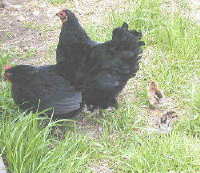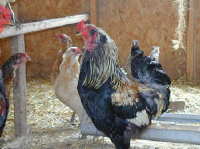
Truly Farm Fresh Eggs
Meat and Eggs Home
Lamb
Pork
Eggs
| The people who've eaten eggs just a day or two after they were laid by the hen all agree--there's an incredible difference of freshness, quality, and flavor when compared to store-bought eggs laid by factory hens. It's particularly obvious when you crack an egg onto a pan for frying. The yolk stands up tall, the white is compact and clear. A taste treat for the eyes as well as a feast for the mouth! |  Shaltz Farm Eggs |
First came a couple of cats, then five angora rabbits, then a half dozen Bantam hens and a Bantam rooster, fondly named Frank after Frank Perdue, joined us on the farm in 1998. The rabbits and chickens shared a shed, but we soon found that didn't work very well. Chickens like to roost! They roosted on top of the rabbit cages--not a good thing. So we built another shed next door that summer and moved the chickens as soon as we could.
On Shaltz Farm, our chickens have access to the outdoors any time they like, at all seasons. They can eat grass, weeds, bugs, and kitchen scraps, or they can eat specially-blended mixes of grains grown without chemicals. No antibiotics, hormones, or other chemicals are added to their water or feed at any time. They are healthy and happy--at least, as happy as their tiny chicken brains allow!
Our Chickens
We had two types of chickens at Shaltz Farm: small Bantam Cochins and medium sized Ameraucana chickens.
Bantams lay very small brown eggs. The chickens are small in size as well. The roosters can be white or a variety of colors, while the hens are most often black or chocolate. Once in a while a beautiful golden orange hen will be born.
 Two bantam hens and the Araucana chicks they hatched |
Bantam hens are good mothers. They patiently sit on the nest for four weeks, rarely leaving their eggs. When the babies begin hatching, mom keeps them under her for a day or so to make sure all the viable eggs are hatched. Then she takes her chicks for their first walk. In this picture, two hens sat on and hatched the same clutch of eggs. The chicks are the small brown fuzzy things toward the right side of the picture. The hen takes care of the chicks for several months, teaching them how to scratch for bugs and eat grass. This is the ideal way to raise chickens, as they need far less store-bought feed and don't bother gardens when raised like this. |
| The Ameraucana chickens are a cross from Araucanas, which lay green and blue eggs, sometimes other colors as well. These eggs are normal medium sized chicken eggs, they just have the lovely shell color. Ameraucana chickens are much larger than the Bantams, but still smaller than meat chickens. |  Americauna Rooster |
Freshness and Health
Eggs are gathered twice a day from nest boxes in the chicken shed. The boxes are filled regularly with clean straw or hay so the eggs are clean when collected. Because our chickens have free access to sunlight and fresh air, and because they're not crowded together like factory chickens, they are never sick and need no medications or other chemicals to treat them. These conditions make for healthy, chemical-free eggs. While the eggs should be cooked fully before eating, and should be stored in the refrigerator, you can be sure they won't make you sick.
| Egg Conversions and Recipes | |||
|---|---|---|---|
| Egg Conversions | Easy Omelette | Toad in the Hole | Spaetzle Noodles |
Conversions for Recipes
Some customers have been uncertain about how to use our eggs, which are smaller than eggs in a store--typically the yolk is about the same size, but there is less white. Here's a handy way to convert for recipes:
- 4-6 whole large or extra large eggs equals one cup of egg. If your recipe calls for two extra large eggs, for example, simply use a measuring cup and break Bantam or Ameraucana eggs into the cup until you have 1/2 cup of egg collected. A little more or less won't hurt most recipes.
- In recipes calling for egg whites only, use about double the number of eggs called for in the recipe, or measure the exact amount (for example, 1/4 cup) of white called for. About 8-10 standard egg whites equals one cup.
- Recipes which use egg yolks are nearly a one for one equivalent between store eggs and our eggs. If you're using Bantam eggs, we suggest you add one egg yolk for every three called for in the recipe. So if your recipe needs four yolks, use five Bantam egg yolks. Ameraucana egg yolks are almost as large as store egg yolks. If you want, add an extra yolk for every five yolks called for in the recipe. Approximately 12-14 large or extra large egg yolks equal one cup.
| Back to Top |
Easy Omelette
Serves one hearty or two moderate appetites and takes about 10 minutes to prepare.
- Chop your choice of fillings for your omelette--up to about 3/4 cups. Suggestions include ham, cheese, tomatoes, green peppers, onions, salsa, peas. Meats should be already cooked, while other ingredients should be either fast to cook or good when still raw.
- Use a non-stick cooking griddle or omelette pan, or spray the pan with cooking spray, or oil your pan very lightly with vegetable oil. Preheat on medium.
- Break 5 Bantam or 4 Ameraucana eggs into a cup and beat with a fork until well mixed.
- Pour eggs onto pan, tilting pan until egg covers the bottom fairly evenly. Allow to cook about one minute, or until bottom of egg mixture is set but top is still liquidy.
- Sprinkle fillings evenly over omelette in a strip about 2 inches wide across the width of the pan, about 2 inches from one edge.
- Using a spatula or pancake turner, flip the 2 inch section of egg over the filling, then continue rolling the omelette toward the other side of the pan.
- Slide omelette to center of pan and continue cooking 2-3 minutes longer.
- Turn off heat, slide omelette onto plate, and enjoy!
- Butter one side of a slice of sandwich bread.
- Cut a hole centered in the bread, about 3 inches in diameter. A biscuit cutter works well.
- Preheat griddle on medium heat. Place bread (plus the piece cut from the center, on the side, if you like) on the griddle, butter side down.
- Carefully break an egg so it falls gently into the hole. Farm fresh egg yolks are more delicate than store-bought, so be very careful to not break the yolk.
- Fry until bread is golden and white is opaque.
- If desired, flip and fry other side until egg is cooked to desired degree.
- Serve hot and fresh!
- Fill a large kettle or dutch oven with water, and bring to a rolling boil.
- Mix 6 cups flour with 2 teaspoons salt in a large bowl.
- Break 2 cups eggs into measuring cup, and mix thoroughly until a uniform color.
- Mix eggs and 1.5 cups water into flour, making a very gooey, slightly drippy, dough.
- Ideally you will have a spaetzle maker to put the dough through. This consists of a flat metal piece, covered with holes, that fits over your pot, with a sliding hopper to hold dough. Lacking that, a ricer will work. If you don't have a ricer, place a portion of dough on a plate, hold plate over boiling water tilted so the dough begins to slide off slowly, and use a knife to 'slice' drips of dough from the edge of the plate (dip knife in boiling water between noodles to keep dough from sticking).
- Time 1 minute from when the last noodle rises to the top of the water, then scoop out and into a pan or bowl with melted butter; stir well to keep from sticking.
- Repeat until all dough is cooked and serve hot.
Toad in the Hole
This easy recipe is known by a variety of names, but Toad in the Hole is the one I like best. Fast to make, it's a little different presentation of fried eggs. Prepare 1-2 per person.
| Back to Top |
Spaetzle Noodles
Spaetzle are another German specialty that we learned to love while stationed there. Although you can occasionally find boxed spaetzle at the grocery store to boil and serve, the flavor isn't nearly as good as fresh, homemade noodles. It's not particularly difficult...unless, of course, you're timing it to coincide with serving schnitzel, in which case enlist some help with the noodles! This amount feeds 4-6 people heartily. Spaetzle is also ideal under Hungarian Goulash Soup.
| Site Map | Back to Top | Contact Us | Feedback |